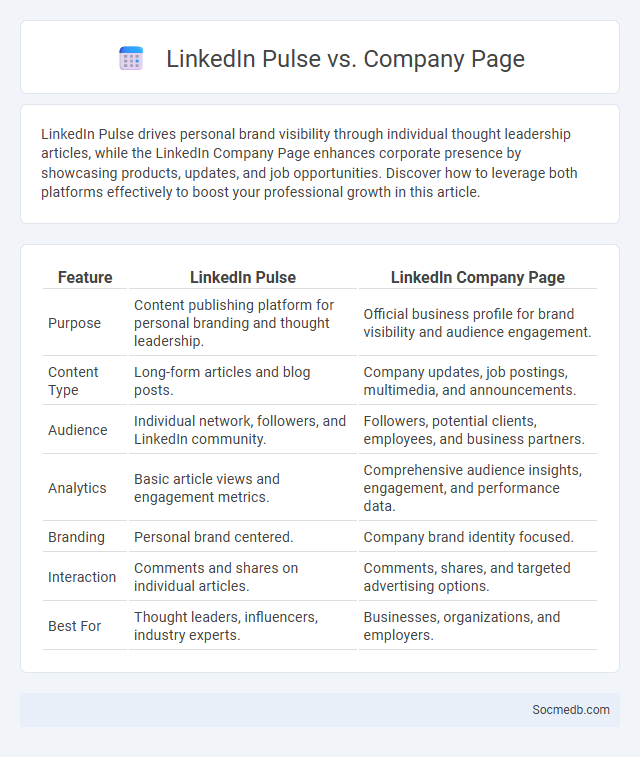
Photo illustration: LinkedIn Pulse vs Company Page
LinkedIn Pulse drives personal brand visibility through individual thought leadership articles, while the LinkedIn Company Page enhances corporate presence by showcasing products, updates, and job opportunities. Discover how to leverage both platforms effectively to boost your professional growth in this article.
Table of Comparison
| Feature | LinkedIn Pulse | LinkedIn Company Page |
|---|---|---|
| Purpose | Content publishing platform for personal branding and thought leadership. | Official business profile for brand visibility and audience engagement. |
| Content Type | Long-form articles and blog posts. | Company updates, job postings, multimedia, and announcements. |
| Audience | Individual network, followers, and LinkedIn community. | Followers, potential clients, employees, and business partners. |
| Analytics | Basic article views and engagement metrics. | Comprehensive audience insights, engagement, and performance data. |
| Branding | Personal brand centered. | Company brand identity focused. |
| Interaction | Comments and shares on individual articles. | Comments, shares, and targeted advertising options. |
| Best For | Thought leaders, influencers, industry experts. | Businesses, organizations, and employers. |
Overview of LinkedIn Pulse, Company Page, and Pulse
LinkedIn Pulse offers a powerful platform for publishing industry-relevant articles that boost your visibility and authority among professionals. A LinkedIn Company Page serves as a branded hub, allowing you to share updates, showcase products, and engage followers with tailored content. Leveraging both Pulse and your Company Page strategically enhances your professional presence and drives meaningful connections within your industry network.
Key Differences Between LinkedIn Pulse and Company Page
LinkedIn Pulse offers a platform for publishing long-form content and thought leadership articles, enhancing your personal brand visibility through targeted content distribution. In contrast, a LinkedIn Company Page serves as a centralized hub for showcasing your business, sharing updates, job postings, and engaging with followers to strengthen your corporate identity. Your strategic use of Pulse boosts individual influence, while the Company Page fosters brand awareness and community building at the organizational level.
Purpose and Audience: Pulse vs Company Page
Pulse on LinkedIn serves professionals looking for industry news and thought leadership, allowing users to discover tailored content that aligns with their interests and expertise. Company Pages target businesses aiming to engage customers, showcase products, and build brand identity by sharing updates and company-related information. Understanding your audience's needs on each platform ensures content resonates effectively, driving meaningful engagement and growth.
Content Formats: What Can You Share?
Social media platforms support diverse content formats including text posts, images, videos, live streams, Stories, and reels, each designed to engage audiences uniquely. Short-form videos, such as TikTok clips or Instagram Reels, drive high user interaction, while infographics and carousel posts effectively convey detailed information. User-generated content, polls, and interactive features like quizzes further enhance engagement, making varied content formats essential for maximizing reach and impact.
Visibility and Reach: Pulse vs Company Page
Your visibility on social media varies significantly between a Pulse article and a Company Page; Pulse content often gains broader exposure through LinkedIn's algorithm favoring individual posts, increasing organic reach beyond your immediate network. Company Pages primarily attract followers who have deliberately opted in, making their reach more targeted but potentially limited in scale. Optimizing both channels around relevant keywords and industry trends can maximize your overall social media impact.
Engagement Metrics Comparison
Engagement metrics such as likes, comments, shares, and click-through rates serve as crucial indicators of your social media performance, revealing how effectively your content resonates with your audience. Platforms like Instagram typically boast higher engagement rates compared to Facebook or Twitter, making it essential for your strategy to align with where your audience is most active. Monitoring these metrics closely allows you to refine your content strategy, improve audience interaction, and maximize your social media impact.
Best Use Cases for LinkedIn Pulse
LinkedIn Pulse excels as a platform for sharing industry insights, thought leadership, and professional achievements, helping you establish credibility within your niche. It is ideal for publishing in-depth articles that attract targeted audiences, drive engagement, and foster meaningful networking opportunities. Leveraging Pulse for content marketing enhances brand visibility and supports career advancement by showcasing your expertise to recruiters and peers.
Best Use Cases for LinkedIn Company Page
LinkedIn Company Pages excel in B2B marketing by enabling targeted content sharing that enhances brand visibility among professionals. They serve as powerful platforms for recruiting top talent by showcasing company culture, job openings, and employee testimonials. Leveraging LinkedIn's analytics helps businesses optimize post engagement and track lead generation effectively.
SEO and Discoverability on LinkedIn
Optimizing your LinkedIn profile for SEO enhances your discoverability by integrating relevant keywords into your headlines, summaries, and experience sections, aligning closely with your industry and target audience. Leveraging LinkedIn's algorithm through consistent content sharing, engaging with connections, and using hashtags relevant to your niche boosts visibility and attracts meaningful network growth. Ensuring your profile is complete with endorsements, recommendations, and up-to-date contact information helps You stand out in searches and improves your professional credibility.
Choosing the Right Platform for Your Content Strategy
Selecting the ideal social media platform depends on your target audience's demographics and content type, such as Instagram for visual storytelling or LinkedIn for professional networking. Analyze user engagement metrics and platform algorithms to maximize reach and interaction tailored to your content strategy. Prioritizing platforms where your audience is most active ensures optimized brand visibility and effective content delivery.
 socmedb.com
socmedb.com